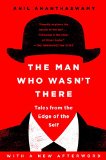Summary | Excerpt | Reviews | Beyond the Book | Readalikes | Genres & Themes | Author Bio
Investigations into the Strange New Science of the Self

Critics' Opinion:
Readers' Opinion:
First Published:
Aug 2015, 320 pages
Paperback:
Aug 2016, 320 pages
 Book Reviewed by:
Book Reviewed by:
James Broderick
Buy This Book
The patient had lost weight, his beard was unkempt and overgrown, and he had stopped bathing because he felt he had no right to take showers and use up too much water. The hospital decided to make a film about him (for their archives) while he was still in the throes of Cotard's. At one point in the filming, the patient pulled a white sheet over his head. "I'm so bad, I don't want people looking at that film to be touched by such badness," he told de Carvalho, who was behind the camera. Dr. de Carvalho pointed out that it was just a film, he couldn't possibly affect anyone through it. "And he said, 'I know, but it's like that; I am so bad,'" de Carvalho told me. Also, the broader culture had again influenced the man's delusion. He was convinced he was responsible for the AIDS epidemic and that people would get AIDS just by watching the film.
Many months later, after the man had recovered (the treatment included ECT), de Carvalho watched the film with his former patient. At the end of the twelve-minute film, the man turned to de Carvalho and said, "Well, this is very interesting. But who is it?" De Carvalho thought the man was joking.
"That's you," de Carvalho told the man.
"No, it's not me," the man replied.
Soon, de Carvalho realized that there was no point trying to convince him. He was not the same man as the one who had descended into the darkness that is Cotard's.
Given such extreme depression during Cotard's, psychiatrists have wondered why most sufferers don't attempt suicide. Partly, it's because the patients are unable to act, like deer caught in headlights. But de Carvalho thinks they don't attempt suicide because they feel they are already dead. "And you can't be more dead than dead."
When Zeman began talking with Graham and realized the extent of his depression and delusion, he suspected an underlying neurological cause. Something had altered Graham's sense of self and perception of his environment. There was one neurologist who would know what to look for: Steven Laureys at the University of Liège in Belgium. Zeman took Graham's consent and sent him to Liège with a community psychiatric nurse in tow. Graham reached the university hospital in Liège and asked for Dr. Laureys.
The secretary called. Laureys, like Zeman, will never forget the phone call: "Doctor, I have a patient here who is telling me he is dead. Please come over."
Many of the patients Laureys sees are in a bad way. Some are comatose, some in a state of unresponsive wakefulness (previously called vegetative), others are minimally conscious, and yet others are people suffering from locked-in syndrome (those who are conscious but completely paralyzed, and are sometimes able to move only their eyes).
After more than a decade of work with such patients as well as healthy subjects, Laureys's team has identified a network of key brain regions in the frontal lobe (the part of the cortex beneath the forehead) and the parietal lobe (which is behind the frontal lobe). He considers activity in this network to be the signature of conscious awareness. This awareness can be analyzed in two dimensions, he told me. One is awareness of the external world: everything you perceive through your senses, whether it's vision, touch, smell, sound, or taste. The other dimension is internal awareness, something more closely related to the self, which includes the internal perception of one's body, thoughts that are triggered regardless of external stimuli, mental imagery and daydreaming, much of which is self-referential. "It's an oversimplification to reduce this very rich complexity we call consciousness, but I think it's meaningful to take those two dimensions," he emphasized.
And indeed, Laureys's team has shown that the frontoparietal network associated with conscious awareness is actually two different networks. Activity in one correlates with awareness of the external: a network of lateral frontoparietal brain areas—the regions on the outer side of the frontal and parietal lobes. The other correlates with awareness of the internal and is potentially related to aspects of the self: a network of areas along the brain's midline—the inner parts of the frontal and parietal lobes, near the cleft that separates the two hemispheres of the brain.
Excerpted from The Man Who Wasn't There by Anil Ananthaswamy. Copyright © 2015 by Anil Ananthaswamy. Excerpted by permission of Dutton. All rights reserved. No part of this excerpt may be reproduced or reprinted without permission in writing from the publisher.





The Funeral Cryer by Wenyan Lu
Debut novelist Wenyan Lu brings us this witty yet profound story about one woman's midlife reawakening in contemporary rural China.
Your guide toexceptional books
BookBrowse seeks out and recommends the best in contemporary fiction and nonfiction—books that not only engage and entertain but also deepen our understanding of ourselves and the world around us.